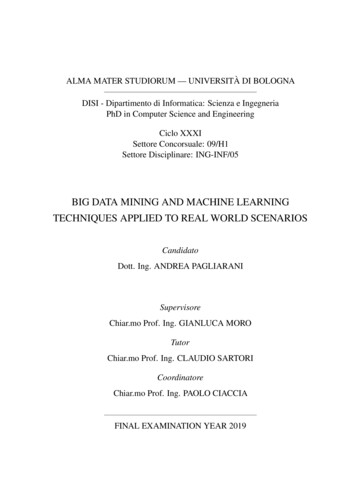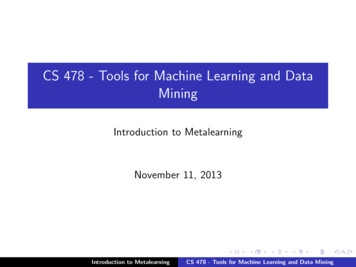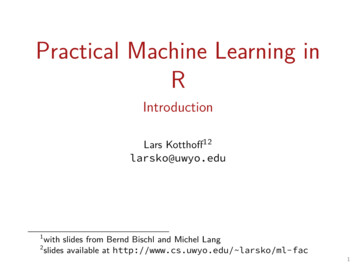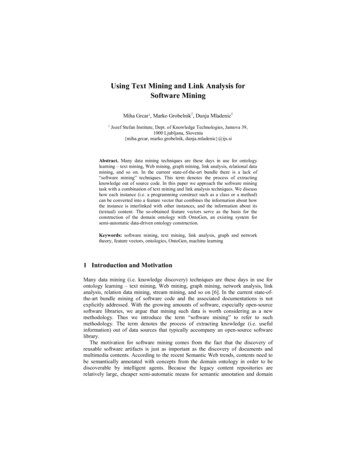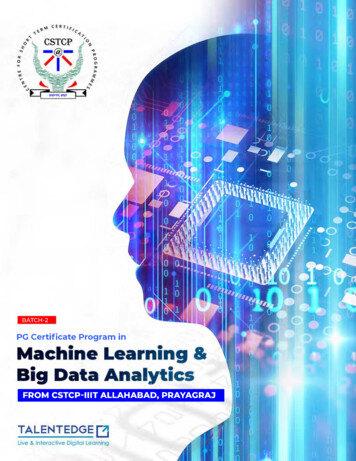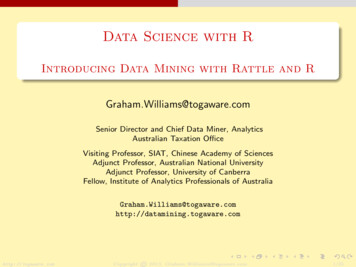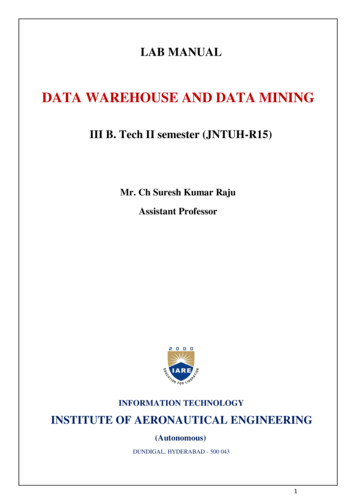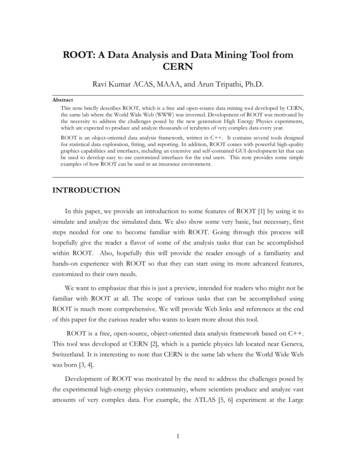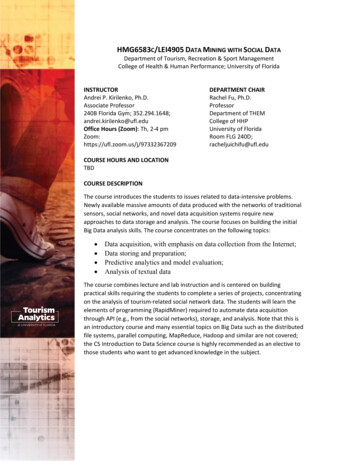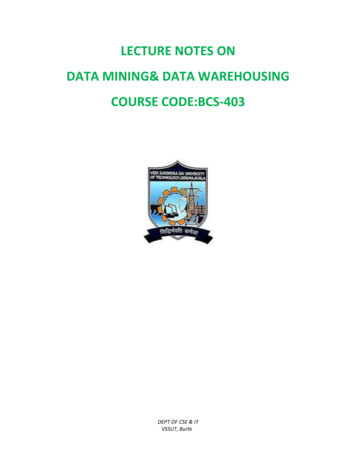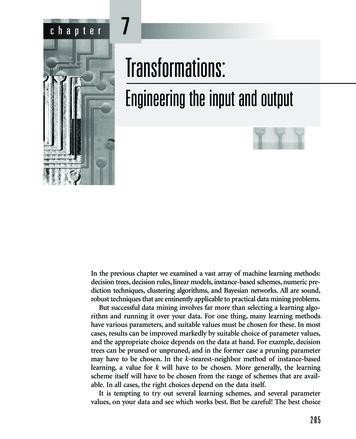
Transcription
chapter7Transformations:Engineering the input and outputIn the previous chapter we examined a vast array of machine learning methods:decision trees, decision rules, linear models, instance-based schemes, numeric prediction techniques, clustering algorithms, and Bayesian networks. All are sound,robust techniques that are eminently applicable to practical data mining problems.But successful data mining involves far more than selecting a learning algorithm and running it over your data. For one thing, many learning methodshave various parameters, and suitable values must be chosen for these. In mostcases, results can be improved markedly by suitable choice of parameter values,and the appropriate choice depends on the data at hand. For example, decisiontrees can be pruned or unpruned, and in the former case a pruning parametermay have to be chosen. In the k-nearest-neighbor method of instance-basedlearning, a value for k will have to be chosen. More generally, the learningscheme itself will have to be chosen from the range of schemes that are available. In all cases, the right choices depend on the data itself.It is tempting to try out several learning schemes, and several parametervalues, on your data and see which works best. But be careful! The best choice285
286CHAPTER 7 TRANSFORMATIONS: ENGINEERING THE INPUT AND OUTPUTis not necessarily the one that performs best on the training data. We haverepeatedly cautioned about the problem of overfitting, where a learned modelis too closely tied to the particular training data from which it was built. It isincorrect to assume that performance on the training data faithfully representsthe level of performance that can be expected on the fresh data to which thelearned model will be applied in practice.Fortunately, we have already encountered the solution to this problem inChapter 5. There are two good methods for estimating the expected true performance of a learning scheme: the use of a large dataset that is quite separatefrom the training data, in the case of plentiful data, and cross-validation(Section 5.3), if data is scarce. In the latter case, a single 10-fold crossvalidation is typically used in practice, although to obtain a more reliableestimate the entire procedure should be repeated 10 times. Once suitable parameters have been chosen for the learning scheme, use the whole training set—allthe available training instances—to produce the final learned model that is tobe applied to fresh data.Note that the performance obtained with the chosen parameter value duringthe tuning process is not a reliable estimate of the final model’s performance,because the final model potentially overfits the data that was used for tuning.To ascertain how well it will perform, you need yet another large dataset that isquite separate from any data used during learning and tuning. The same is truefor cross-validation: you need an “inner” cross-validation for parameter tuningand an “outer” cross-validation for error estimation. With 10-fold crossvalidation, this involves running the learning scheme 100 times. To summarize:when assessing the performance of a learning scheme, any parameter tuningthat goes on should be treated as though it were an integral part of the training process.There are other important processes that can materially improve successwhen applying machine learning techniques to practical data mining problems,and these are the subject of this chapter. They constitute a kind of data engineering: engineering the input data into a form suitable for the learning schemechosen and engineering the output model to make it more effective. You canlook on them as a bag of tricks that you can apply to practical data mining problems to enhance the chance of success. Sometimes they work; other times theydon’t—and at the present state of the art, it’s hard to say in advance whetherthey will or not. In an area such as this where trial and error is the most reliable guide, it is particularly important to be resourceful and understand whatthe tricks are.We begin by examining four different ways in which the input can be massaged to make it more amenable for learning methods: attribute selection,attribute discretization, data transformation, and data cleansing. Consider thefirst, attribute selection. In many practical situations there are far too many
7.1AT TRIBUTE SELECTION287attributes for learning schemes to handle, and some of them—perhaps the overwhelming majority—are clearly irrelevant or redundant. Consequently, the datamust be preprocessed to select a subset of the attributes to use in learning. Ofcourse, learning methods themselves try to select attributes appropriately andignore irrelevant or redundant ones, but in practice their performance can frequently be improved by preselection. For example, experiments show thatadding useless attributes causes the performance of learning schemes such asdecision trees and rules, linear regression, instance-based learners, and clustering methods to deteriorate.Discretization of numeric attributes is absolutely essential if the task involvesnumeric attributes but the chosen learning method can only handle categoricalones. Even methods that can handle numeric attributes often produce betterresults, or work faster, if the attributes are prediscretized. The converse situation, in which categorical attributes must be represented numerically, alsooccurs (although less often); and we describe techniques for this case, too.Data transformation covers a variety of techniques. One transformation,which we have encountered before when looking at relational data in Chapter2 and support vector machines in Chapter 6, is to add new, synthetic attributeswhose purpose is to present existing information in a form that is suitable forthe machine learning scheme to pick up on. More general techniques that donot depend so intimately on the semantics of the particular data mining problem at hand include principal components analysis and random projections.Unclean data plagues data mining. We emphasized in Chapter 2 the necessity of getting to know your data: understanding the meaning of all the different attributes, the conventions used in coding them, the significance of missingvalues and duplicate data, measurement noise, typographical errors, and thepresence of systematic errors—even deliberate ones. Various simple visualizations often help with this task. There are also automatic methods of cleansingdata, of detecting outliers, and of spotting anomalies, which we describe.Having studied how to massage the input, we turn to the question of engineering the output from machine learning schemes. In particular, we examinetechniques for combining different models learned from the data. There aresome surprises in store. For example, it is often advantageous to take the training data and derive several different training sets from it, learn a model fromeach, and combine the resulting models! Indeed, techniques for doing this canbe very powerful. It is, for example, possible to transform a relatively weaklearning method into an extremely strong one (in a precise sense that we willexplain). Moreover, if several learning schemes are available, it may be advantageous not to choose the best-performing one for your dataset (using crossvalidation) but to use them all and combine the results. Finally, the standard,obvious way of modeling a multiclass learning situation as a two-class one canbe improved using a simple but subtle technique.
288CHAPTER 7 TRANSFORMATIONS: ENGINEERING THE INPUT AND OUTPUTMany of these results are counterintuitive, at least at first blush. How can itbe a good idea to use many different models together? How can you possiblydo better than choose the model that performs best? Surely all this runs counterto Occam’s razor, which advocates simplicity. How can you possibly obtain firstclass performance by combining indifferent models, as one of these techniquesappears to do? But consider committees of humans, which often come up withwiser decisions than individual experts. Recall Epicurus’s view that, faced withalternative explanations, one should retain them all. Imagine a group of specialists each of whom excels in a limited domain even though none is competentacross the board. In struggling to understand how these methods work,researchers have exposed all sorts of connections and links that have led to evengreater improvements.Another extraordinary fact is that classification performance can often beimproved by the addition of a substantial amount of data that is unlabeled, inother words, the class values are unknown. Again, this seems to fly directly inthe face of common sense, rather like a river flowing uphill or a perpetualmotion machine. But if it were true—and it is, as we will show you in Section7.6—it would have great practical importance because there are many situationsin which labeled data is scarce but unlabeled data is plentiful. Read on—andprepare to be surprised.7.1 Attribute selectionMost machine learning algorithms are designed to learn which are the mostappropriate attributes to use for making their decisions. For example,decision tree methods choose the most promising attribute to split on ateach point and should—in theory—never select irrelevant or unhelpfulattributes. Having more features should surely—in theory—result in morediscriminating power, never less. “What’s the difference between theoryand practice?” an old question asks. “There is no difference,” the answer goes,“—in theory. But in practice, there is.” Here there is, too: in practice, addingirrelevant or distracting attributes to a dataset often “confuses” machine learning systems.Experiments with a decision tree learner (C4.5) have shown that adding tostandard datasets a random binary attribute generated by tossing an unbiasedcoin affects classification performance, causing it to deteriorate (typically by 5%to 10% in the situations tested). This happens because at some point in the treesthat are learned the irrelevant attribute is invariably chosen to branch on,causing random errors when test data is processed. How can this be, when decision tree learners are cleverly designed to choose the best attribute for splittingat each node? The reason is subtle. As you proceed further down the tree, less
7.1AT TRIBUTE SELECTION289and less data is available to help make the selection decision. At some point,with little data, the random attribute will look good just by chance. Because thenumber of nodes at each level increases exponentially with depth, the chance ofthe rogue attribute looking good somewhere along the frontier multiplies up asthe tree deepens. The real problem is that you inevitably reach depths at whichonly a small amount of data is available for attribute selection. If the datasetwere bigger it wouldn’t necessarily help—you’d probably just go deeper.Divide-and-conquer tree learners and separate-and-conquer rule learnersboth suffer from this effect because they inexorably reduce the amount of dataon which they base judgments. Instance-based learners are very susceptible toirrelevant attributes because they always work in local neighborhoods, takingjust a few training instances into account for each decision. Indeed, it has beenshown that the number of training instances needed to produce a predetermined level of performance for instance-based learning increases exponentiallywith the number of irrelevant attributes present. Naïve Bayes, by contrast, doesnot fragment the instance space and robustly ignores irrelevant attributes. Itassumes by design that all attributes are independent of one another, an assumption that is just right for random “distracter” attributes. But through this verysame assumption, Naïve Bayes pays a heavy price in other ways because its operation is damaged by adding redundant attributes.The fact that irrelevant distracters degrade the performance of state-of-theart decision tree and rule learners is, at first, surprising. Even more surprisingis that relevant attributes can also be harmful. For example, suppose that in atwo-class dataset a new attribute were added which had the same value as theclass to be predicted most of the time (65%) and the opposite value the rest ofthe time, randomly distributed among the instances. Experiments with standarddatasets have shown that this can cause classification accuracy to deteriorate (by1% to 5% in the situations tested). The problem is that the new attribute is (naturally) chosen for splitting high up in the tree. This has the effect of fragmenting the set of instances available at the nodes below so that other choices arebased on sparser data.Because of the negative effect of irrelevant attributes on most machine learning schemes, it is common to precede learning with an attribute selection stagethat strives to eliminate all but the most relevant attributes. The best way toselect relevant attributes is manually, based on a deep understanding of thelearning problem and what the attributes actually mean. However, automaticmethods can also be useful. Reducing the dimensionality of the data by deleting unsuitable attributes improves the performance of learning algorithms. Italso speeds them up, although this may be outweighed by the computationinvolved in attribute selection. More importantly, dimensionality reductionyields a more compact, more easily interpretable representation of the targetconcept, focusing the user’s attention on the most relevant variables.
290CHAPTER 7 TRANSFORMATIONS: ENGINEERING THE INPUT AND OUTPUTScheme-independent selectionWhen selecting a good attribute subset, there are two fundamentally differentapproaches. One is to make an independent assessment based on general characteristics of the data; the other is to evaluate the subset using the machinelearning algorithm that will ultimately be employed for learning. The first iscalled the filter method, because the attribute
when applying machine learning techniques to practical data mining problems, and these are the subject of this chapter. They constitute a kind of data engi-neering:engineering the input data into a form suitable for the learning scheme chosen and engineering the output model to make it more effective. You can look on them as a bag of tricks that you can apply to practical data mining prob-lems .
